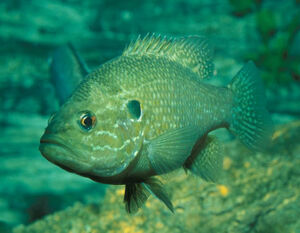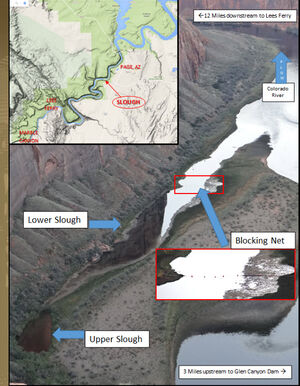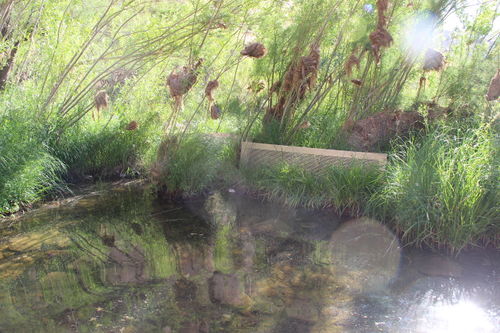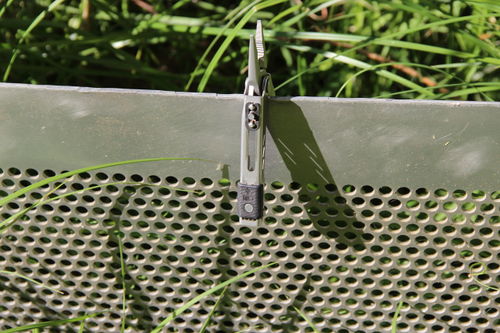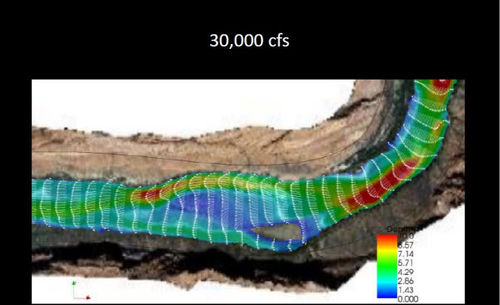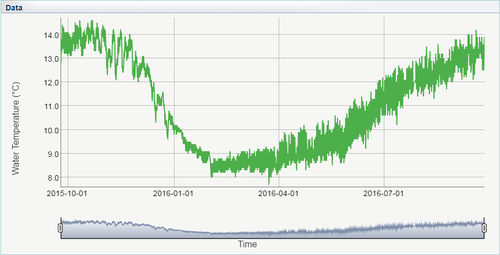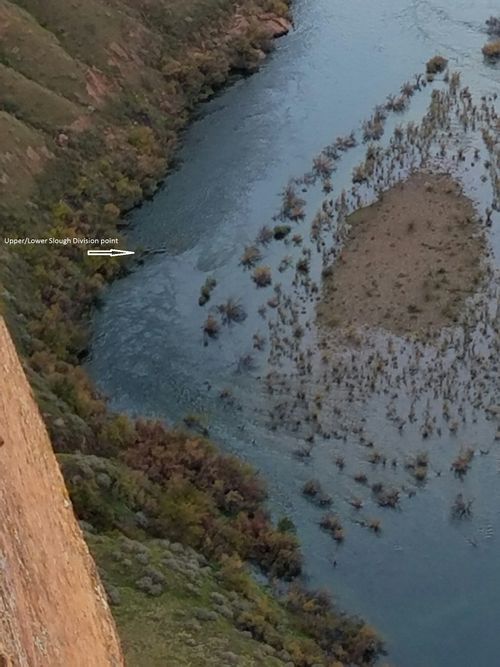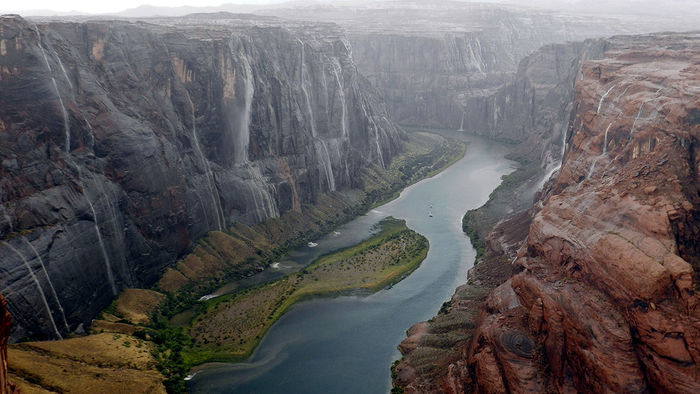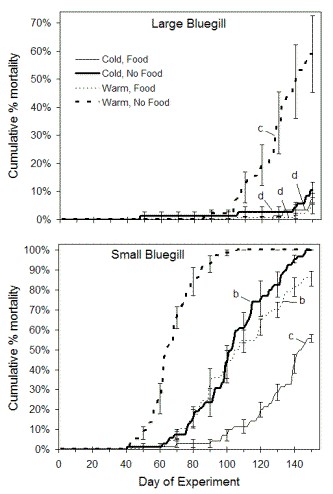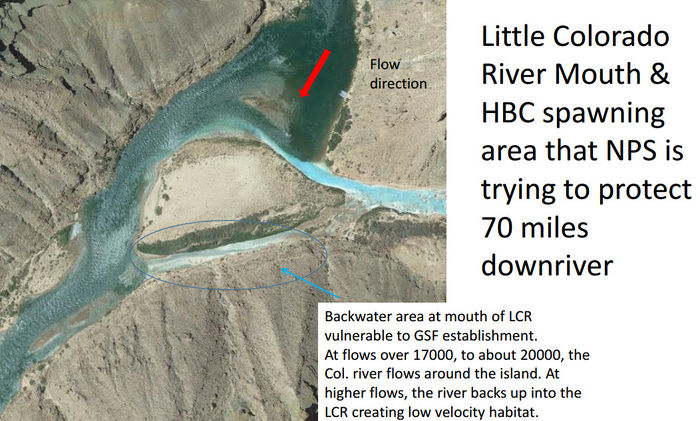Difference between revisions of "Green Sunfish Page"
Cellsworth (Talk | contribs) |
Cellsworth (Talk | contribs) |
||
| (58 intermediate revisions by the same user not shown) | |||
| Line 17: | Line 17: | ||
</table> | </table> | ||
| − | [[File: | + | [[File:GreenSunfish2.jpg|center|300px]] <br> |
| − | + | [[File:Slough.jpg|center|300px]] <br> | |
| − | [[File: | + | |
| − | + | ||
| − | + | ||
<!-- | <!-- | ||
| Line 28: | Line 25: | ||
|style="width:60%; font-size:120%;"| | |style="width:60%; font-size:120%;"| | ||
| − | == | + | == '''Green Sunfish (''Lepomis cyanellus'')'''== |
| − | + | Green sunfish were earliest of the smaller sunfishes to be introduced into Arizona, first being | |
| − | + | collected in 1926 (Minckley 1973). It is characterized by its large mouth with bluegreen | |
| + | striations on the cheeks. The opercle flap is black with a reddish or orange border. The body | ||
| + | is olivegreen in color, with dark vertical bars on the sides. The pectoral fin is short and | ||
| + | rounded and the caudal fin and lower fin margins are white or yellowish with dusky spots at | ||
| + | the rear of the dorsal and anal fins. Length is about 3 to 12 inches with the typical weight | ||
| + | ranging between 3 ounces to 1 pound 8 ounces (AGFD 2006). | ||
| − | + | The green sunfish can be found in most warm water lakes and streams in Arizona and even | |
| − | + | in a few trout lakes in the White Mountains and Mogollon Rim. This fish is highly adaptable, | |
| + | but tends to become most abundant in rocky situations of either lakes or streams, where | ||
| + | other sunfish are absent or uncommon. | ||
| − | + | Green sunfish will eat anything they can catch and swallow. Insects, crayfish, fish and frogs | |
| − | + | are all in danger when green sunfish are present. | |
| − | + | Green sunfish are remarkably tolerant of crowding among themselves. Under such | |
| − | + | conditions, they often become stunted in size creating management problems in small lakes. | |
| + | Large populations apparently compete with the young of other fishes for food, or prey upon | ||
| + | them, thus causing negative impacts to both game and native fishes (Minckley 1973). | ||
| − | + | Green sunfish is the most piscivorous member of its genus (Dudley and Matter 2000). | |
| − | + | According to Moyle and Nichols (1973, 1974), green sunfish were probably responsible for | |
| − | + | the elimination of California roach (Hesperoleucus symmetricus) in the San Joaquin valley of | |
| − | + | California because of heavy predation on the young. In a study in North Carolina (Lemly | |
| − | + | 1985), removal of green sunfish from streams led to the increase in the biomass and | |
| − | + | numbers of most native species. [https://www.usbr.gov/lc/phoenix/biology/azfish/pdf/greensunfish.pdf] | |
| − | + | ||
| − | + | ||
| − | + | ||
| − | + | ||
| − | + | ||
|}<!-- | |}<!-- | ||
| Line 58: | Line 59: | ||
----------Strapline immediately below banner----------> | ----------Strapline immediately below banner----------> | ||
{| style="width:100%; height:50px" border=1px solid #ccc; background:#cedff2 | {| style="width:100%; height:50px" border=1px solid #ccc; background:#cedff2 | ||
| − | ! style="width=33%; background:#cedff2;" | [ | + | ! style="width=33%; background:#cedff2;" | [http://gcdamp.com/images_gcdamp_com/7/7a/140619_FISH_IN_RIVER_GCDAMPwiki-_AZGF.PDF Online training] <br> |
| − | ! style="width=33%; background:#cedff2;" | | + | ! style="width=33%; background:#cedff2;" | Fish Species of the Colorado River in Lower Glen Canyon and Grand Canyon <br> |
| − | Fish Species of the Colorado River in Lower Glen Canyon and Grand Canyon <br> | + | ! style="width=33%; background:#cedff2;" | [http://gcdamp.com/index.php?title=Table-_Fish_Species_of_the_CR-_GLEN_and_Grand Fish photos, information, and maps] <br> |
| − | + | ||
| − | [http://gcdamp.com/index.php?title=Table-_Fish_Species_of_the_CR-_GLEN_and_Grand Fish photos, information, and maps] <br> | + | |
| − | + | ||
|} | |} | ||
| Line 73: | Line 71: | ||
|style="color:#000;"| | |style="color:#000;"| | ||
| − | == | + | ==2018== |
| − | + | Green sunfish were again found reproducing in the upper slough in June 2018 even though there has not been an HFE since the last chemical treatment of the slough. Peak flows since the last treatment were approximately 17,000 cfs in January, March, and June 2018. | |
| − | + | ==2017== | |
| − | + | Five green sunfish were collected in the upper slough in May 2017. NPS is electrofishing and has traps out to remove as many green sunfish from the upper slough before they start reproducing. NPS has placed a screen between the upper and lower sloughs to try and prevent more green sunfish from getting into the upper slough. | |
| − | + | ||
| − | + | ||
| − | + | ||
| − | + | ||
| − | + | ||
| − | + | ||
| − | + | [[File:IMG 6808.JPG|thumb|center|500px|Screen between the upper and lower sloughs]] <br> | |
| + | [[File:IMG 6815.JPG|thumb|center|500px|Screen mesh is about 1/4"]] <br> | ||
| + | |||
| + | NPS tried covering the upper slough with black plastic to cook off the remaining fish but that method was unsuccessful. GCMRC conducted an ammonia treatment in October which they feel was 100% successful. There was no HFE in 2017 because of a lack of sediment inputs. Screens will still be in place through 2018. | ||
| + | |||
| + | ==2016== | ||
In August 2016, NPS reported the results of a survey they did in response to a report from AZGF that there may be green sunfish again in the Upper Slough in Glen Canyon. An infestation of green sunfish in this slough was why an HFE was not held in the fall of 2015. NPS reported on 8/16/2016: "Two Grand Canyon National Park technicians made a quick sample in the Upper Slough with a backpack electrofisher on Friday (August 12). Due to a river emergency downstream, they had limited time on site, but completed one sample (574 seconds) along the muddy shore on the river side of the slough. They captured 26 green sunfish and saw many more. Some captured green sunfish were in the 20 mm size range. A block net is still installed between the sloughs, but is compromised at current flows." NPS, Reclamation, USFWS, AZGF, and GCMRC are organizing to come up with both a short-term plan that addresses this latest infestation and to come up with a long-term fix for this problem. The hope is to have this addressed in some fashion before the end of the current HFE window as to not interfere with the possibility of conducting an HFE this fall. | In August 2016, NPS reported the results of a survey they did in response to a report from AZGF that there may be green sunfish again in the Upper Slough in Glen Canyon. An infestation of green sunfish in this slough was why an HFE was not held in the fall of 2015. NPS reported on 8/16/2016: "Two Grand Canyon National Park technicians made a quick sample in the Upper Slough with a backpack electrofisher on Friday (August 12). Due to a river emergency downstream, they had limited time on site, but completed one sample (574 seconds) along the muddy shore on the river side of the slough. They captured 26 green sunfish and saw many more. Some captured green sunfish were in the 20 mm size range. A block net is still installed between the sloughs, but is compromised at current flows." NPS, Reclamation, USFWS, AZGF, and GCMRC are organizing to come up with both a short-term plan that addresses this latest infestation and to come up with a long-term fix for this problem. The hope is to have this addressed in some fashion before the end of the current HFE window as to not interfere with the possibility of conducting an HFE this fall. | ||
| + | |||
| + | (10/24/16) The ammonia treatment to eradicate green sunfish from the isolated pond at river mile -12 in Glen Canyon began at approximately noon on Thursday October 20, 2016 when crews applied 20 gallons of ammonia to the pond. Dead and dying green sunfish were observed within about 90 minutes. To help confirm the effectiveness of the treatment, 14 cages with from 3 to 20 sentinel green sunfish each were placed in locations throughout the pond. Crews checked the pond at 1430 hours and observed dead green sunfish on the bottom of the pond and in the sentinel cages although not all the sentinel fish were dead. Crews returned to the pond the morning of Friday October 21, 2016 and found that all the sentinel green sunfish were dead. They also counted 939 dead juvenile green sunfish as well as 10 dead carp, 7 adults and 3 juveniles. The crews electrofished the pond and collected 3 live juvenile green sunfish and 1 live juvenile carp from one small area near the upstream end of the pond where a small amount of water was flowing into the pond. These fish appeared to have been affected by the ammonia, but hadn’t yet succumbed unlike other dead green sunfish observed in this same small area. The captured green sunfish were sacrificed and crews poured in one gallon of ammonia to spot treat this area to ensure any other remaining fish would be killed. No other live fish were observed. Ammonia levels in the pond will remain at levels lethal to green sunfish for 7 to 14 days, thus we are confident that the treatment will eradicate green sunfish from this site. Another electrofishing survey is scheduled for Tuesday October 25, 2016 to confirm green sunfish have been eliminated from the pond. Surveys for green sunfish at two other locations in Glen Canyon that might be suitable for rearing of young fish were also conducted this week. Two baited minnow traps were set at “frog marsh” at rive mile -8 and four baited minnow traps at the hidden slough at rive mile -6.5 on Wednesday October 19, 2016. The traps were retrieved after 24 hours and no fish were captured. <br> --Scott VanderKooi, GCMRC | ||
| + | |||
| + | '''2016 Summary''' | ||
| + | *10 removal trips from August - October captured and removed 4,600 green sunfish from the upper slough. | ||
| + | *Based on depletion sampling, the final estimate before the ammonia treatment was that there should be approximately 261 (95% CI: 192-343) green sunfish and no carp remaining in the upper slough. [https://www.usbr.gov/uc/rm/amp/twg/mtgs/16oct18/Attach_06a.pdf] | ||
| + | *939 juvenile green sunfish and 10 carp were recovered from the slough following the treatment. | ||
| + | *Mechanical removal (electrofishing, netting, trapping), even in a small pond like the upper slough, is unlikely to be effective in removing or controlling green sunfish. | ||
| + | *Depletion sampling is unlikely to give an accurate number of green sunfish remaining in the slough prior to an HFE. | ||
==2015== | ==2015== | ||
| − | |||
| − | ---- | + | In July 2015 AGFD biologists discovered an unusually large, reproducing population of invasive green sunfish in the slough. Green sunfish are prolific, with a single female producing up to 10,000 eggs. They are also voracious predators of native fish and their eggs. Biologists with the AGFD, NPS, USGS, FWS, and BOR determined that green sunfish pose a threat to native fish including the [http://gcdamp.com/index.php?title=Humpback_Chub_Page '''humpback chub (''Gila cypha'')''']. A rapid response action is necessary to eradicate the population of sunfish before it spreads downstream into critical habitat for the endangered humpback chub. [http://www.nps.gov/glca/learn/news/Rapid-Response-Treatment-to-Remove-Invasive-Green-Sunfish-from-a-Backwater-Slough.htm (2015 NPS Press Release)] This resulted in the cancellation of the [http://gcdamp.com/index.php?title=GCDAMP-_HFE_2015 fall 2015 HFE]. |
| + | |||
| + | '''Results from 2015 removals:''' <br> | ||
| + | *July 6: 43 (all lower slough) <br> | ||
| + | *August 12-14: 954 <br> | ||
| + | *August 27-28: 2,574 <br> | ||
| + | *October 27-29: 775 (39 lower, 736 upper) <br> | ||
| + | *November 15: 1,967 (rotenone treatment; 180 lower, 1,787 upper) <br> | ||
| + | |||
| + | '''Presentations and Photos:''' | ||
| + | *[http://www.lcrmscp.gov/crab/presentations/2016/crab16_34.pdf Green Sunfish Removal in a Colorado River Backwater Below Glen Canyon Dam ] | ||
| + | *[https://www.usbr.gov/uc/progact/amp/twg/2016-02-26-twg-meeting/Attach_05b.pdf Colorado River Slough Green Sunfish Removal] | ||
| + | *[https://www.usbr.gov/uc/progact/amp/twg/2016-02-26-twg-meeting/Attach_05a.pdf Green Sunfish Rapid Response Treatment, Nov 2-6 and Nov 12-13, 2015 Brief Treatment Summary] | ||
| + | *[https://goo.gl/photos/e9fYmrEWVeEBujiA6 Photos of the 2015 green sunfish treatment] | ||
| − | + | [[File:SloughConnection.jpg|thumb|center|500px|Two-dimensional streamflow model of predicted water surface extent and depths in Lees Ferry, RM -12 slough showing full connection at modeled flows of 30,000 cfs]] <br> | |
| − | + | ||
| − | - | + | |
| − | + | ||
| − | - | + | |
| − | + | ||
| − | [[file: | + | [[file:LeesFerryDischarge2015 2016.jpg|center|500px]] |
| + | [[file:LeesFerryTemperature2015 2016.jpg|thumb|center|500px|Colorado River discharge and temperature measured at Lees Ferry from fall 2015 to fall 2016.]] <br> | ||
| − | [[File: | + | [[File:GSF sloughs HFE 11102016 KH.jpg|thumb|center|500px|The Slough during the 2016 HFE at 38,000 cfs]] <br> |
| − | + | ||
| − | |||
| − | |||
| − | |||
|} | |} | ||
| Line 123: | Line 133: | ||
|style="color:#000;"| | |style="color:#000;"| | ||
| + | *[http://gcdamp.com/index.php?title=Nonnative_Invasive_Aquatic_Species Nonnative Invasive Aquatic Species] | ||
*[http://www.nwrc.usgs.gov/wdb/pub/hsi/hsi-015.pdf Habitat Suitability Index Models: Green Sunfish] | *[http://www.nwrc.usgs.gov/wdb/pub/hsi/hsi-015.pdf Habitat Suitability Index Models: Green Sunfish] | ||
| − | *[http:// | + | *[http://gcdamp.com/index.php?title=National_Park_Service_Expanded_Non-native_Aquatic_Species_Management_Plan_and_EA 2019 National Park Service Expanded Non-native Aquatic Species Management Plan] |
| + | *[http://gcdamp.com/index.php?title=2013_National_Park_Service_Comprehensive_Fisheries_Management_Plan 2013 National Park Service Comprehensive Fisheries Management Plan] | ||
| + | *[[GCDAMP 2016 Fish PEP| 2016 Fish Protocol Evaluation Panel (PEP)]] | ||
*[http://gcdamp.com/index.php?title=The_HFE_Page The High Flow Experiment (HFE) Page] | *[http://gcdamp.com/index.php?title=The_HFE_Page The High Flow Experiment (HFE) Page] | ||
| + | *[http://youtu.be/dq3yvvEjsOo| Demo video that shows how to do an ammonia treatment to remove invasive aquatic species] | ||
| + | |||
| + | |- | ||
| + | ! <h2 style="margin:0; background:#cedff2; font-size:120%; font-weight:bold; border:1px solid #a3b0bf; text-align:left; color:#000; padding:0.2em 0.4em;"> [http://gcdamp.com/index.php?title=National_Park_Service_Expanded_Non-native_Aquatic_Species_Management_Plan_and_EA NPS Non-Native Fish EA] </h2> | ||
| + | |- | ||
| + | |style="color:#000;"| | ||
| + | |||
| + | Update: 5/23/2017 <br> EA will address a permanent solution and will include green sunfish and brown trout in the Lees Ferry reach. Public review process is starting and there will be a public scoping meeting in June. Draft EA by early 2018. Leads: NPS (GCNRA and GCNP). Cooperating Agencies: | ||
| + | |||
| + | ---- | ||
| + | |||
| + | The NPS hosted a webinar on October 27, 2016 for stakeholders and interested parties to develop a range of options for '''Long Term Risk Reduction for Green Sunfish in the -12 RM sloughs''', and other invasive fish species and locations in the Lees Ferry Reach of Glen Canyon National Recreation Area. This 'brainstorming' session provided the basis for developing a range of alternatives to be analyzed in a Long Term Risk Reduction Plan and Environmental Assessment to be completed and implemented by October 2017. For more information contact Melissa Trammell at [email protected]. | ||
| + | *[[Media:Glen Canyon Sloughs & Green Sunfish Control Email Version.pdf| Monitoring and Management of Non-native Fish in Glen Canyon NRA and Grand Canyon NP, October 2016 Workshop]] | ||
| + | *[[Media:Lees Ferry pre scoping.pdf| Scoping for an NPS Environmental Assessment for a Long Term Risk Reduction Plan for Invasive Nonnative Fish in Glen Canyon NRA and Grand Canyon NP]] | ||
|- | |- | ||
| Line 131: | Line 158: | ||
|- | |- | ||
|style="color:#000;"| | |style="color:#000;"| | ||
| + | |||
| + | '''2020''' | ||
| + | *Green Sunfish Status and Trends in the Western Grand Canyon – contact Brian Healy, NPS | ||
| + | |||
| + | '''2018''' | ||
| + | *[[Media:GlenCanyonSloughTemperatureOptions FINAL.pdf| Temperature Reduction Options for Glen Canyon Slough; RM -12, Technical Report No. SRH 2018-17, Upper Colorado Regional Office Colorado River, AZ]] | ||
| + | |||
| + | '''2017''' | ||
| + | *[https://www.lcrmscp.gov/crab/presentations/2017/crab17_35.pdf Eradication of Green Sunfish from the Lees Ferry Slough using liquid ammonia] | ||
'''2016''' | '''2016''' | ||
| − | *[ | + | *[[Media:Glen Canyon Sloughs & Green Sunfish Control Email Version.pdf| Monitoring and Management of Non-native Fish in Glen Canyon NRA and Grand Canyon NP, October 2016 Workshop]] |
| + | *[[Media:Lees Ferry pre scoping.pdf| Scoping for an NPS Environmental Assessment for a Long Term Risk Reduction Plan for Invasive Nonnative Fish in Glen Canyon NRA and Grand Canyon NP]] | ||
| + | *[https://www.usbr.gov/uc/progact/amp/twg/2016-10-18-twg-meeting/Attach_06a.pdf Fall 2016 HFE Planning PPT] | ||
| + | *[https://www.usbr.gov/uc/progact/amp/amwg/2016-08-24-amwg-meeting/Attach_07a.pdf Grand Canyon Monitoring and Research Center Science Updates (BO Compliance, Trout Updates, Green Sunfish, Fisheries PEP, Partners in Science)] | ||
*[http://www.lcrmscp.gov/crab/presentations/2016/crab16_34.pdf Green Sunfish Removal in a Colorado River Backwater Below Glen Canyon Dam ] | *[http://www.lcrmscp.gov/crab/presentations/2016/crab16_34.pdf Green Sunfish Removal in a Colorado River Backwater Below Glen Canyon Dam ] | ||
| − | *[ | + | *[https://www.usbr.gov/uc/progact/amp/twg/2016-02-26-twg-meeting/Attach_05a.pdf Green Sunfish Rapid Response Treatment, Nov 2-6 and Nov 12-13, 2015 Brief Treatment Summary] |
| − | *[ | + | *[https://www.usbr.gov/uc/progact/amp/twg/2016-02-26-twg-meeting/Attach_05b.pdf Colorado River Slough Green Sunfish Removal] |
| − | *[ | + | *[https://www.usbr.gov/uc/progact/amp/twg/2016-02-26-twg-meeting/Attach_05c.pdf Installation of Nets to Contain Green Sunfish in Minus-12-Mile Slough, Glen Canyon National Recreation Area, Oct 6-7, 2015 Trip Report] |
'''2015''' | '''2015''' | ||
*[http://www.deseretnews.com/article/865640047/Rapid-response-treatment-to-remove-invasive-green-sunfish-from-a-backwater-slough.html?pg=all Desert News: Rapid response treatment to remove invasive green sunfish from a backwater slough] | *[http://www.deseretnews.com/article/865640047/Rapid-response-treatment-to-remove-invasive-green-sunfish-from-a-backwater-slough.html?pg=all Desert News: Rapid response treatment to remove invasive green sunfish from a backwater slough] | ||
| − | *[ | + | *[https://www.usbr.gov/uc/progact/amp/twg/2015-10-20-twg-meeting/Attach_05a.pdf Invasive species threats: Green sunfish] |
| − | *[ | + | *[https://www.usbr.gov/uc/progact/amp/twg/2015-10-20-twg-meeting/Attach_05b.pdf Green Sunfish Rapid Response Non-native Fish Control in Glen Canyon National Recreation Area] |
| + | *[https://www.usbr.gov/uc/progact/amp/twg/2015-10-20-twg-meeting/Attach_10a.pdf DOI: Approval of Recommendation for No Experimental High-Flow Release from Glen Canyon Dam, November 2015] | ||
*[[Media:2015 Recommendations Report Final HFE Tech Team Report 10-15-15.pdf| DOI Tech Team Report: Final Recommendation to Not Implement a Fall 2015 High Flow Experiment at Glen Canyon Dam]] | *[[Media:2015 Recommendations Report Final HFE Tech Team Report 10-15-15.pdf| DOI Tech Team Report: Final Recommendation to Not Implement a Fall 2015 High Flow Experiment at Glen Canyon Dam]] | ||
*[[Media:Green sunfish RA Sept 30 2015-final.pdf| GCMRC: Green Sunfish Lepomis cyanellus; Risk Assessment for the Colorado River ecosystem (CRe)]] | *[[Media:Green sunfish RA Sept 30 2015-final.pdf| GCMRC: Green Sunfish Lepomis cyanellus; Risk Assessment for the Colorado River ecosystem (CRe)]] | ||
| − | |||
*[https://drive.google.com/file/d/0BwY-Z2c3NTUGQURtV2s3eWJqRHM/view Updates on 2014 HFE, 2015 Paria sediment inputs, and 2015 sediment mass balance] | *[https://drive.google.com/file/d/0BwY-Z2c3NTUGQURtV2s3eWJqRHM/view Updates on 2014 HFE, 2015 Paria sediment inputs, and 2015 sediment mass balance] | ||
| + | |||
| + | '''1993''' | ||
| + | *[[Media:Zigler 1993 SunfishGrowthSurvival.pdf| Zigler, S.J and C.A. Jennings. 1993. Growth and Mortality of Larval Sunfish in Backwaters of the Upper Mississippi River. Transactions of the American Fisheries Society 122:6(6)]] | ||
|- | |- | ||
| − | ! <h2 style="margin:0; background:#cedff2; font-size:120%; font-weight:bold; border:1px solid #a3b0bf; text-align:left; color:#000; padding:0.2em 0.4em;"> | + | ! <h2 style="margin:0; background:#cedff2; font-size:120%; font-weight:bold; border:1px solid #a3b0bf; text-align:left; color:#000; padding:0.2em 0.4em;">Other Stuff</h2> |
|- | |- | ||
|style="color:#000;"| | |style="color:#000;"| | ||
| − | |||
| − | |||
| − | + | [[File:GSF Sloughs Rainstorm Sep-2-2016.jpg|center|700px|thumbnail| http://gcdamp.com/images_gcdamp_com/d/d2/Glen_Canyon_Sloughs_%26_Green_Sunfish_Control_Email_Version.pdf ]] | |
| − | + | '''Description:''' | |
| + | Native to the Great Lakes, Hudson Bay and the Mississippi River basin. Introduced into Arizona in 1926. Large mouth with blue-green striations on the cheeks. Opercle flap is black with reddish or orange border. Bodies olive-green in color, dark vertical bars are faintly seen on sides. Pectoral fin short and rounded. Caudal fin and lower fin margins are white or yellowish with dusky spots at rear of dorsal and anal fins. Length: 3 to 12 inches. Weight: 3 ounces to 1 pound 8 ounces. May live to nine years. | ||
| − | + | '''Location and Habitat:''' | |
| − | + | Found in most seasonally warm water lakes and streams in Arizona. Prefer lakes with rocky substrate and piles of rubble, but can be found in slow moving rivers and riverine backwaters. Green sunfish have been found at a wide range of stream gradients, varying from 0.2 to 5.7 m/km; however, they are most abundant at lower (<2 m/km) gradients. They prefer small to medium-sized (<30 m width) streams.[http://www.nwrc.usgs.gov/wdb/pub/hsi/hsi-015.pdf] Being native to the Great Lakes and Mississippi River Basin, green sunfish are well suited to tolerate long periods of cold water. | |
| − | + | ||
| − | + | '''Temperature:''' | |
| − | + | Being native to the Great Lakes and Mississippi River Basin, green sunfish are well suited to tolerate long periods of cold water. The summertime temperature preference for adult green sunfish is 28.2° C and, when possible, they avoid temperatures above 31° C or below 26° C. Growth and food conversion efficiency increase as temperature increases from 13.2 to 28° C. Optimal temperatures for fry range from 18 to 26° C. The range of tolerance for bluegill fry is 10 to 36° C, and it is assumed that green sunfish fry tolerances are similar. Temperature requirements for juveniles are assumed to be the same as those for adults.[http://www.nwrc.usgs.gov/wdb/pub/hsi/hsi-015.pdf] 2015-2016 temperatures in the mainstem ranged from 8.0-15.5 C between Lees Ferry and the Little Colorado River. 2015-2016 temperatures in the Little Colorado River ranged from 10.0-28.0 C and are within the temperature tolerances of green sunfish spawning and growth. | |
| − | + | ||
| − | + | ||
| − | [[ | + | '''[http://gcdamp.com/index.php?title=GCDAMP_Sediment| Turbidity] and Dissolved Oxygen:''' |
| − | + | Green sunfish tolerate greater turbidity and lower dissolved oxygen than other sunfish.[http://www.dnr.state.mn.us/fish/sunfish/biology.html] Moderate (25-100 JTU) turbidities correlated with high species abundance are optimum.[http://www.nwrc.usgs.gov/wdb/pub/hsi/hsi-015.pdf] Ventilation rates were not affected by bentonite clay suspensions below 2,125 FTU at 5 C, 1,012 FTU at 15 C, and 898 FTU at 25 C. At turbidity levels exceeding 1,012 FTU at 15 C and 898 FTU at 25 C ventilation rates increased 50-70%. Oxygen consumption rates were not affected by turbid suspensions of up to 3,500 FTU at any of the four temperatures.[http://www.tandfonline.com/doi/abs/10.1577/1548-8659(1976)105%3C107%3AEOTOVR%3E2.0.CO%3B2] | |
| + | |||
| + | '''Salinity:''' | ||
| + | Green sunfish have preferred salinity tolerances <0.36% and will not tolerate salinity >0.56%.[http://www.nwrc.usgs.gov/wdb/pub/hsi/hsi-015.pdf] The Little Colorado River has a naturally high salinity at baseflow ranging from 0.22% - 0.36%.[https://pubs.er.usgs.gov/publication/70040717] | ||
| + | |||
| + | '''Reproduction:''' | ||
| + | Optimal temperature for spawning and subsequent development ranges from 20 to 27° C. Spawning will not occur below 19° C or above 31° C.[http://www.nwrc.usgs.gov/wdb/pub/hsi/hsi-015.pdf] Males build nests in shallow pools over gravel, sand or bedrock. The nests are usually within a couple feet of each other. The male guards the nest and hatched fry. Males constantly show defensive displays and fight with other males who come too close. It is thought that green sunfish may produce the same number of eggs as bluegill, which is roughly 50,000 eggs per female. It takes normally 1 to 2 days for the eggs to hatch and another 5 to 7 days of protection from the male until the fry become independent. Green sunfish can spawn up to every 8 to 10 days during the spawning season.[http://www.biokids.umich.edu/critters/Lepomis_cyanellus/] | ||
| + | |||
| + | '''Food:''' | ||
| + | Green sunfish will eat anything they can catch and swallow. Aquatic and terrestrial insects and invertebrates are the most common food items. Small crayfish, humpback chub, and frogs are all in danger when green sunfish are present. Young life stages of chub do not persist in streams occupied by Green Sunfish. No recruitment of young-of-year Gila Chub (''Gila intermedia'') occurred in the presence of sunfish in Sabino Creek, Arizona (Dudley and Matter, 2000). | ||
| + | |||
| + | '''Risk:''' | ||
| + | Green sunfish may temporarily be displaced into colder more unfavorable environments where survival might be lower, but the fish that do survive will seek out warm backwaters and tributaries after moving downstream. An upstream source that continues to allow new individuals to disperse downstream and colonize tributaries, when they are not in flood stage, greatly increases the likelihood of sunfish establishment in tributaries of the CRe. If no action is taken, there is a high risk of sunfish spreading downstream and becoming established in and near other tributaries, primarily the Little Colorado River, where negative impacts to the endangered humpback chub will occur.[[Media:Green sunfish RA Sept 30 2015-final.pdf| (Green Sunfish Risk Assessment)]] | ||
==[https://experts.illinois.edu/en/publications/body-size-food-and-temperature-affect-overwinter-survival-of-age- The Effect of Temperature and Food Availability on Size-Specific Overwinter Survival in Age-0 bluegill.] == | ==[https://experts.illinois.edu/en/publications/body-size-food-and-temperature-affect-overwinter-survival-of-age- The Effect of Temperature and Food Availability on Size-Specific Overwinter Survival in Age-0 bluegill.] == | ||
| + | [[File:Bluegill overwinter mortality.jpg|right|800px]] | ||
'''Shoup, D.E., and Wahl, D.H. 2011. Body size, food, and temperature affect overwinter survival of age-0 bluegill. Transactions of the American Fisheries Society 140:1298-1304.''' | '''Shoup, D.E., and Wahl, D.H. 2011. Body size, food, and temperature affect overwinter survival of age-0 bluegill. Transactions of the American Fisheries Society 140:1298-1304.''' | ||
Fish with protracted spawning often have high variability in length of age-0 fish in fall. Several studies from northern climates have found that early-spawned bluegill ''Lepomis macrochirus'', which are larger and therefore have greater energy reserves going into winter, have greater overwinter survival than their smaller late-spawned cohorts. However, other studies investigating bluegill populations at lower latitudes have found that overwinter survival is not size-selective. To examine the interaction of size and winter severity on overwinter survival, we performed an experiment (2 x 2 x 2 factorial) with two size classes (20-30 mm and 50-60 mm) of age-0 bluegill held at two temperatures overwinter (9C and 4C), with or without food. Bluegill were housed in groups of 10 (n=6 replicates) in aquaria within environmental chambers. | Fish with protracted spawning often have high variability in length of age-0 fish in fall. Several studies from northern climates have found that early-spawned bluegill ''Lepomis macrochirus'', which are larger and therefore have greater energy reserves going into winter, have greater overwinter survival than their smaller late-spawned cohorts. However, other studies investigating bluegill populations at lower latitudes have found that overwinter survival is not size-selective. To examine the interaction of size and winter severity on overwinter survival, we performed an experiment (2 x 2 x 2 factorial) with two size classes (20-30 mm and 50-60 mm) of age-0 bluegill held at two temperatures overwinter (9C and 4C), with or without food. Bluegill were housed in groups of 10 (n=6 replicates) in aquaria within environmental chambers. | ||
Survival, growth, and condition factor were higher for fed than starved fish at both temperatures. Survival, growth, and condition factor were highest for fed fish at 9C, intermediate for both fed and unfed fish at 4C, and lowest for 9C starved fish. Large fish had similar survival to small fish when fed, but large fish had higher survival than small fish when they were starved. Activity levels during the experiment were highest for fed fish held at 9C. Activity levels were similar for unfed fish at 9C and fed fish at 4C; unfed fish at 4C had the lowest activity level. Fall and spring bluegill collected from 10 lakes in Illinois indicated that the pattern of overwinter mortality is highly variable among systems. We propose that winter food availability and winter severity interact to determine the extent of size-specific mortality experienced by age-0 bluegill in natural systems. <br> | Survival, growth, and condition factor were higher for fed than starved fish at both temperatures. Survival, growth, and condition factor were highest for fed fish at 9C, intermediate for both fed and unfed fish at 4C, and lowest for 9C starved fish. Large fish had similar survival to small fish when fed, but large fish had higher survival than small fish when they were starved. Activity levels during the experiment were highest for fed fish held at 9C. Activity levels were similar for unfed fish at 9C and fed fish at 4C; unfed fish at 4C had the lowest activity level. Fall and spring bluegill collected from 10 lakes in Illinois indicated that the pattern of overwinter mortality is highly variable among systems. We propose that winter food availability and winter severity interact to determine the extent of size-specific mortality experienced by age-0 bluegill in natural systems. <br> | ||
| − | [[File: | + | |
| + | ---- | ||
| + | |||
| + | [[File:LCR slough1.jpg|thumb|center|700px|"Slough-like habitat" at the mouth of the LCR. ]] | ||
| + | |||
| + | [http://gcdamp.com/images_gcdamp_com/d/d2/Glen_Canyon_Sloughs_%26_Green_Sunfish_Control_Email_Version.pdf Establishment of a green sunfish population at the slough at the mouth of the LCR would be especially problematic in terms of difficulty to control and potential to affect humpback chub.] | ||
| + | |||
| + | |- | ||
| + | ! <h2 style="margin:0; background:#cedff2; font-size:120%; font-weight:bold; border:1px solid #a3b0bf; text-align:left; color:#000; padding:0.2em 0.4em;">Acceptable Risk Calculations for GSF</h2> | ||
| + | |- | ||
| + | |style="color:#000;"| | ||
| + | *[[media:Propagule-melissa-2016.pdf| Consideration of Propagule Size in the Establishment of Nonnative Fish in Reservoirs & Rivers]] | ||
| + | *[[media:BASINWIDENNFSTRATEGYFeb2014.pdf| see Appendix G: Propagule Pressure in the 2014 Upper Colorado River Basin Nonnative and Invasive Aquatic Species Prevention and Control Strategy]] | ||
| + | |||
| + | Summary of an email from Melissa Trammell (NPS) 9/7/16: | ||
| + | |||
| + | Melissa has been looking into deriving a defensible acceptable risk number of green sunfish in the lower slough before conducting an HFE this year. She has been evaluating some work done by retired FWS biologist Pat Martinez who has done extensive work evaluating illegal introductions of nonnative fish into various water bodies in the upper Colorado River Basin by looking at how many introductions, and the number of fish per introduction, were necessary before populations became established. The species Martinez examined were walleye, smallmouth bass, and northern pike; invasive species of concern in the upper Colorado River Basin. Green sunfish are most analogous to smallmouth bass in this example. If you look at slide 11 [[media:Propagule-melissa-2016.pdf| in his ppt]], Martinez calculated that it took a mean of 1.25 adult SMB (a minimum of 0.25 SMB) per surface acre of receiving water body, to establish a population in the waterbodies he evaluated. He applied this value to rivers, particularly the Yampa River, by looking at total river miles times average width to get total surface acres. The point of the analysis was that the Program's removal targets for smallmouth bass for the Yampa River were about the same as the mean number needed for establishing a population, which indicated the Program needed to adjust their removal targets down. | ||
| + | |||
| + | Melissa noted that the calculation she gives below is a very conservative estimate, since GSF is less likely to establish a population in a river environment than a lake or pond, also, the calculation assumes the fish are adult, which is not the case for the GSF in the sloughs - they are primarily young-of-year. The calculation for the Colorado River below the sloughs down to the Little Colorado River, which is our area of primary concern, and applying the minimum of 0.25 fish per surface acre, suggests that 656 GSF released from the sloughs could establish a population somewhere in the Colorado River between Glen Canyon and the LCR. Given David Ward's (GCMRC) calculation that we captured about 12% of the total number of GSF present on any single electrofishing pass last year, that means a theoretical one-pass capture of 78 fish likely would represent a total population in the lower slough of 656 fish. Clay Nelson (GCMRC) only captured 4 (counting the ones in the little channel) in 40 minutes of sampling in the lower slough indicating that there were only about 33 GSF present in the lower slough when he sampled. Subsequent sampling on Sept 1-2 only produced 10 GSF in the lower slough; much lower densities than this risk assessment would consider problematic. Last year, in the lower slough, we removed about 1,800 GSF before the treatment, and collected about 200 afterwards. AGFD has suggested 100 GSF in the lower slough as an upper limit for an acceptable risk number and Ken (GCNRA) suggested 5 mature GSF/hour electrofishing. These are both much more conservative targets than the above calculations. | ||
| + | |||
| + | In summary, Melissa suggests that a very conservative acceptable risk value for the number of GSF in the lower slough prior to an HFE would be 300 GSF of any size, about 50% of the value calculated from Martinez' analysis. This number could either be calculated from depletion estimates as we progress through the removal effort, or by using 12% as the capture probability, thus a final pass should produce less than 36 total fish (12% of 300). If the number of fish remaining in the lower slough after all mechanical removal efforts is greater than that, she suggests moving towards implementing another rotenone treatment of the lower slough before conducting an HFE. | ||
|} | |} | ||
Latest revision as of 14:40, 25 July 2022
|
Green Sunfish (Lepomis cyanellus)Green sunfish were earliest of the smaller sunfishes to be introduced into Arizona, first being collected in 1926 (Minckley 1973). It is characterized by its large mouth with bluegreen striations on the cheeks. The opercle flap is black with a reddish or orange border. The body is olivegreen in color, with dark vertical bars on the sides. The pectoral fin is short and rounded and the caudal fin and lower fin margins are white or yellowish with dusky spots at the rear of the dorsal and anal fins. Length is about 3 to 12 inches with the typical weight ranging between 3 ounces to 1 pound 8 ounces (AGFD 2006). The green sunfish can be found in most warm water lakes and streams in Arizona and even in a few trout lakes in the White Mountains and Mogollon Rim. This fish is highly adaptable, but tends to become most abundant in rocky situations of either lakes or streams, where other sunfish are absent or uncommon. Green sunfish will eat anything they can catch and swallow. Insects, crayfish, fish and frogs are all in danger when green sunfish are present. Green sunfish are remarkably tolerant of crowding among themselves. Under such conditions, they often become stunted in size creating management problems in small lakes. Large populations apparently compete with the young of other fishes for food, or prey upon them, thus causing negative impacts to both game and native fishes (Minckley 1973). Green sunfish is the most piscivorous member of its genus (Dudley and Matter 2000). According to Moyle and Nichols (1973, 1974), green sunfish were probably responsible for the elimination of California roach (Hesperoleucus symmetricus) in the San Joaquin valley of California because of heavy predation on the young. In a study in North Carolina (Lemly 1985), removal of green sunfish from streams led to the increase in the biomass and numbers of most native species. [1] |
| Online training |
Fish Species of the Colorado River in Lower Glen Canyon and Grand Canyon |
Fish photos, information, and maps |
|---|
|
|
